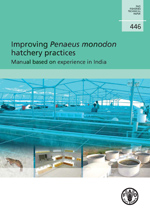Improving penaeus monodon hatchery practices - manual based on experience in india
FAO

The successful farming of tiger shrimp (Penaeus monodon) in India is mainly due to the existence of some 300 hatcheries whose capacity to produce 12 000 million postlarvae (PL) annually has provided an assured supply of seed. However, the sustainability of the sector is still hampered by many problems, foremost among these being a reliance on wild-caught broodstock whose supply is limited both in quantity and in seasonal availability and that are often infected with pathogens. The current low quality of hatchery produced PL due to infection with white spot syndrome virus (WSSV) and other pathogens entering the hatcheries via infected broodstock, contaminated intake water or other sources due to poor hatchery management practices, including inadequate biosecurity, is a major obstacle to achieving sustainable shrimp aquaculture in India and the Asia-Pacific region. Considering the major contribution of the tiger shrimp to global shrimp production and the economic losses resulting from disease outbreaks, it is essential that the shrimp-farming sector invest in good management practices for the production of healthy and quality seed.
This document reviews the current state of the Indian shrimp hatchery industry and provides detailed guidance and protocols for improving the productivity, health management, biosecurity and sustainability of the sector. Following a brief review of shrimp hatchery development in India, the major requirements for hatchery production are discussed under the headings: infrastructure, facility maintenance, inlet water quality and treatment, wastewater treatment, biosecurity, standard operating procedures (SOPS), the Hazard Analysis Critical Control Point (HACCP) approach, chemical use during the hatchery production process and health assessment. Pre-spawning procedures covered include the use of wild, domesticated and specific pathogen free/ specific pathogen resistant (SPF/SPR) broodstock; broodstock landing centres and holding techniques; broodstock selection, transport, utilization, quarantine, health screening, maturation, nutrition and spawning; egg hatching; nauplius selection; egg/ nauplius disinfection and washing and holding, disease testing and transportation of nauplii. Post-spawning procedures covered include: larval-rearing unit preparation, larval rearing/health management, larval nutrition and feed management, important larval diseases, general assessment of larval condition, quality testing/selection of PL for stocking, PL harvest and transportation, nursery rearing, timing of PL stocking, use of multiple species in shrimp hatcheries, and documentation and record keeping. Information on the use of chemicals in shrimp hatcheries and examples of various forms for hatchery record keeping are included as Annexes.
"Tài liệu điện tử trên trang tepbac được chia sẻ để sử dụng cho mục đích học tập và nghiên cứu cá nhân. Nghiêm cấm mọi hình thức sao chép, in ấn phục vụ các mục đích khác nếu không được sự chấp nhận của tác giả và nhà xuất bản."









